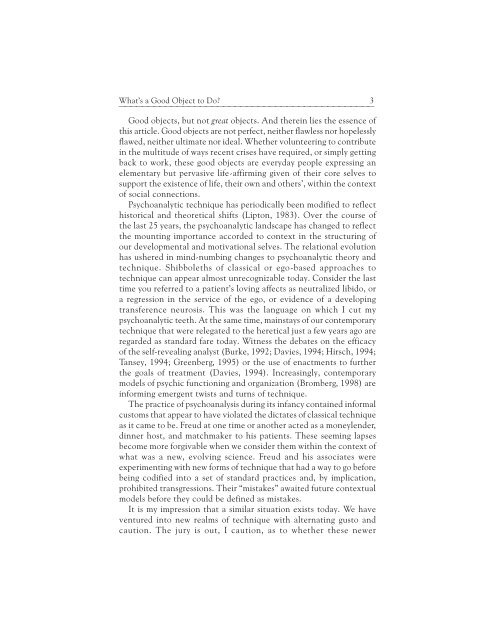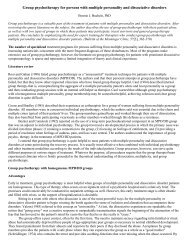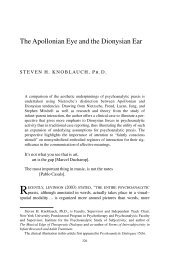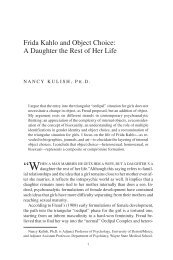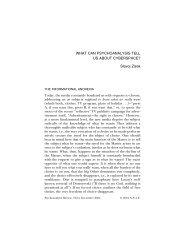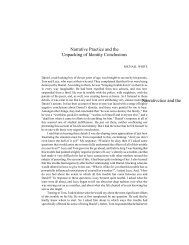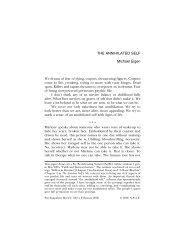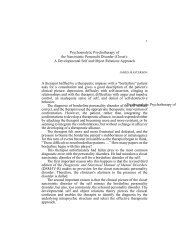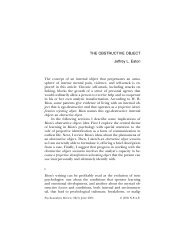What's a Good Object to Do? - PsyBC
What's a Good Object to Do? - PsyBC
What's a Good Object to Do? - PsyBC
You also want an ePaper? Increase the reach of your titles
YUMPU automatically turns print PDFs into web optimized ePapers that Google loves.
What’s a <strong>Good</strong> <strong>Object</strong> <strong>to</strong> <strong>Do</strong> 3<br />
⎯⎯⎯⎯⎯⎯⎯⎯⎯⎯⎯⎯⎯⎯⎯⎯⎯⎯⎯⎯⎯⎯⎯⎯⎯⎯⎯⎯⎯⎯⎯⎯⎯⎯⎯⎯⎯⎯⎯⎯⎯⎯⎯⎯<br />
<strong>Good</strong> objects, but not great objects. And therein lies the essence of<br />
this article. <strong>Good</strong> objects are not perfect, neither flawless nor hopelessly<br />
flawed, neither ultimate nor ideal. Whether volunteering <strong>to</strong> contribute<br />
in the multitude of ways recent crises have required, or simply getting<br />
back <strong>to</strong> work, these good objects are everyday people expressing an<br />
elementary but pervasive life-affirming given of their core selves <strong>to</strong><br />
support the existence of life, their own and others’, within the context<br />
of social connections.<br />
Psychoanalytic technique has periodically been modified <strong>to</strong> reflect<br />
his<strong>to</strong>rical and theoretical shifts (Lip<strong>to</strong>n, 1983). Over the course of<br />
the last 25 years, the psychoanalytic landscape has changed <strong>to</strong> reflect<br />
the mounting importance accorded <strong>to</strong> context in the structuring of<br />
our developmental and motivational selves. The relational evolution<br />
has ushered in mind-numbing changes <strong>to</strong> psychoanalytic theory and<br />
technique. Shibboleths of classical or ego-based approaches <strong>to</strong><br />
technique can appear almost unrecognizable <strong>to</strong>day. Consider the last<br />
time you referred <strong>to</strong> a patient’s loving affects as neutralized libido, or<br />
a regression in the service of the ego, or evidence of a developing<br />
transference neurosis. This was the language on which I cut my<br />
psychoanalytic teeth. At the same time, mainstays of our contemporary<br />
technique that were relegated <strong>to</strong> the heretical just a few years ago are<br />
regarded as standard fare <strong>to</strong>day. Witness the debates on the efficacy<br />
of the self-revealing analyst (Burke, 1992; Davies, 1994; Hirsch, 1994;<br />
Tansey, 1994; Greenberg, 1995) or the use of enactments <strong>to</strong> further<br />
the goals of treatment (Davies, 1994). Increasingly, contemporary<br />
models of psychic functioning and organization (Bromberg, 1998) are<br />
informing emergent twists and turns of technique.<br />
The practice of psychoanalysis during its infancy contained informal<br />
cus<strong>to</strong>ms that appear <strong>to</strong> have violated the dictates of classical technique<br />
as it came <strong>to</strong> be. Freud at one time or another acted as a moneylender,<br />
dinner host, and matchmaker <strong>to</strong> his patients. These seeming lapses<br />
become more forgivable when we consider them within the context of<br />
what was a new, evolving science. Freud and his associates were<br />
experimenting with new forms of technique that had a way <strong>to</strong> go before<br />
being codified in<strong>to</strong> a set of standard practices and, by implication,<br />
prohibited transgressions. Their “mistakes” awaited future contextual<br />
models before they could be defined as mistakes.<br />
It is my impression that a similar situation exists <strong>to</strong>day. We have<br />
ventured in<strong>to</strong> new realms of technique with alternating gus<strong>to</strong> and<br />
caution. The jury is out, I caution, as <strong>to</strong> whether these newer


